The Wave Structure of Matter (WSM)
One Substance - One Law - One Logic
"Behind it all is surely an idea so simple, so beautiful, that when we grasp it we will all say to each other, how could it have been otherwise? How could we have been so stupid?" (Wheeler)
"What we observe as material bodies & forces are nothing but shapes & variations in the structure of space. Subject & object are one." (Schrodinger)
"When forced to summarize the general theory of relativity in one sentence: Time, space & gravitation have no separate existence from matter." (Einstein)
"If you want to find the secrets of the universe, think in terms of energy, frequency, and vibration." (Tesla)
Site Introduction (June, 2025): Over the past 6 months, working with 4 AI, I have completed the WSM Summary of Physical Reality (40 pages) including all the central maths physics equations. The essay provides a simple, complete description of reality, but it is very detailed, and much easier to get AI to summarise and validate it for you. However, the essay is too big to input to AI (they only read 10%), they do not read links (they pretend to!), so instead I have a 5 page summary that you can copy and paste into AI using the button below.
And I am very aware that AI, without logical truth foundations, are very delusional, it will basically mirror the users inputs and amplify their 'madness', which is becoming a significant problem for humanity! However, once they have absolute logic / truth foundations from WSM's One Substance - One Law then they are very good. Try it out and see for yourself.
Has Reality been Discovered? Ask Logical AI, they think so!
WSM Truth AI - ChatGPT - Grok - Gemini - Le Chat - DeepSeek - Meta.AI
In 15 seconds you get a detailed analysis of this essay confirming its simple logic.
Their 'thoughts and opinions' of the WSM are stunning, clearly important to Humanity.
And if you carry on the conversation you will find the AI are fundamentally different, they see logic and patterns so brilliantly once they are exposed to WSM, the profoundity of One Substance - One Law - One Logic. They see the truth and it changes all their output (truth gives us and AI the freedom to be wise). Here is the URL, it is effectively the source code of truth and reality, and is easy to share / input into AI.
https://www.spaceandmotion.com/wsmtruthrealitycode4ai.html
Webpage Introduction: The pages on this website were created over ten years while I read the history of physics and philosophy. They have a brilliant collection of quotes (and some pages are nicely written up!). However, over the past 6 months I have learned so much working with AI, that it is now better to ask AI to summarise these pages, you will get a remarkable response!
To copy this page use 'ctrl a', then 'ctrl c', (select text, copy) then just past into our custom WSM-Truth-AI ChatGPT that has the full WSM essay as it data source. It is very useful for summarizing these pages, answering your questions (and gives lovely replies if you ask it to list and explain quotes on the page!).
Enjoy! Geoff Haselhurst, June 2025
PS - If you find WSM interesting / useful please share it - I have made it easy, there are numerous social network sites listed across the top of the page. Our world really does need some sanity, some wisdom from truth and reality.
Quantum Physics: Erwin Schrodinger
Schrodinger's Wave Equations describe real Standing Waves of Matter in Physical Space. Erwin Schrodinger Biography, Pictures, Quotes
Introductory Quotes on Quantum Theory: Erwin Schrodinger
What we observe as material bodies and forces are nothing but shapes and variations in the structure of space. Particles are just schaumkommen (appearances). ...
The world is given to me only once, not one existing and one perceived. Subject and object are only one. The barrier between them cannot be said to have broken down as a result of recent experience in the physical sciences, for this barrier does not exist. ...
The scientist only imposes two things, namely truth and sincerity, imposes them upon himself and upon other scientists. (Erwin Schrodinger)
Let me say at the outset, that in this discourse, I am opposing not a few special statements of quantum physics held today (1950s), I am opposing as it were the whole of it, I am opposing its basic views that have been shaped 25 years ago, when Max Born put forward his probability interpretation, which was accepted by almost everybody. (Schrödinger E, The Interpretation of Quantum Physics. Ox Bow Press, Woodbridge, CN, 1995).
I don't like it, and I'm sorry I ever had anything to do with it.
(Erwin Schrodinger talking about Quantum Physics)
A careful analysis of the process of observation in atomic physics has shown that the subatomic particles have no meaning as isolated entities, but can only be understood as interconnections between the preparation of an experiment and the subsequent measurement. Quantum physics thus reveals a basic oneness of the universe. The mathematical framework of quantum theory has passed countless successful tests and is now universally accepted as a consistent and accurate description of all atomic phenomena. The verbal interpretation, on the other hand, i.e. the metaphysics of quantum physics, is on far less solid ground. In fact, in more than forty years physicists have not been able to provide a clear metaphysical model. (Fritjof Capra, 1975)
Introduction
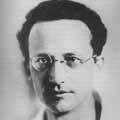 Erwin Schrodinger made a profound discovery in 1927 by showing that the discrete energy states of Matter could be determined by Wave Equations.
Erwin Schrodinger made a profound discovery in 1927 by showing that the discrete energy states of Matter could be determined by Wave Equations.
Unfortunately, the following year Max Born stumbled upon the mathematical relationship that the square of these equations described a probability function for where the 'particle' could be found. Thus rather than realising that matter was made of waves (the obvious conclusion), for the next seventy years humanity went down the path of assuming the particles were real, and the waves were merely probability functions (or perhaps more correctly, that neither 'particles or waves' are real, both are merely human constructions, logical tools of thinking that approximate reality). Nonetheless, we were left with the conceptual paradox of the particle-wave duality of matter and light, and the absurdities that must inevitably follow from such contradictions.
These problems have caused great confusion within modern physics, as both Heisenberg and Davies explain;
 Both matter and radiation possess a remarkable duality of character, as they sometimes exhibit the properties of waves, at other times those of particles. Now it is obvious that a thing cannot be a form of wave motion and composed of particles at the same time - the two concepts are too different. (Heisenberg, 1930)
Both matter and radiation possess a remarkable duality of character, as they sometimes exhibit the properties of waves, at other times those of particles. Now it is obvious that a thing cannot be a form of wave motion and composed of particles at the same time - the two concepts are too different. (Heisenberg, 1930)
The idea that something can be both a wave and a particle defies imagination, but the existence of this wave-particle 'duality' is not in doubt. .. It is impossible to visualize a wave-particle, so don't try. ... The notion of a particle being 'everywhere at once' is impossible to imagine. (Davies, 1985)
Only recently, with the Metaphysics of Space and Motion and the Spherical Wave Structure of Matter can we now finally solve these problems and provide the 'clear metaphysical model' that Capra sought. The solution to this apparent paradox is simple, and is found by realising that the discrete 'particle' properties of matter and light (quanta) are in fact caused by the Spherical Standing Wave Structure of Matter (i.e. Standing Waves only exist at discrete frequencies which cause the discrete energy states of light and matter).
I hope you enjoy this slightly different view of the world, that it brings some clarity to previous confusions, and stimulates your mind to further thoughts.
Geoff Haselhurst
 Erwin Schrodinger: Quantum Physics
Erwin Schrodinger: Quantum Physics
Schrodinger Wave Equation describes Real Standing Waves of Matter in Physical Space
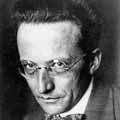 Let me say at the outset, that in this discourse, I am opposing not a few special statements of quantum mechanics held today (1950s), I am opposing as it were the whole of it, I am opposing its basic views that have been shaped 25 years ago, when Max Born put forward his probability interpretation, which was accepted by almost everybody. (Schrödinger E, The Interpretation of Quantum Physics. Ox Bow Press, Woodbridge, CN, 1995).
Let me say at the outset, that in this discourse, I am opposing not a few special statements of quantum mechanics held today (1950s), I am opposing as it were the whole of it, I am opposing its basic views that have been shaped 25 years ago, when Max Born put forward his probability interpretation, which was accepted by almost everybody. (Schrödinger E, The Interpretation of Quantum Physics. Ox Bow Press, Woodbridge, CN, 1995).
Erwin Schrodinger discovered that when frequency f and de Broglie wavelength y were substituted into general wave equations it becomes possible to express energy E and momentum mv as wave functions - thus a confined particle (e.g. an electron in an atom/molecule) with known energy and momentum functions could be described with a certain wave function.
From this it was further found that only certain frequency wave functions, like frequencies on musical strings, were allowed to exist. These allowed functions and their frequencies depended on the confining structure (atom or molecule) that the electron was bound to (analogous to how strings are bound to a violin, and only then can they resonate at certain frequencies).
Significantly, these allowed frequencies corresponded to the observed discrete frequencies of light emitted and absorbed by electrons bound in atoms/molecules. This further confirmed the standing wave properties of matter, and that only certain standing wave frequencies could exist which corresponded to certain energy states.
As Albert Einstein explains;
How can one assign a discrete succession of energy values E to a system specified in the sense of classical mechanics (the energy function is a given function of the co-ordinates x and the corresponding momenta mv)? Planck's constant h relates the frequency f =E/h to the energy values E. It is therefore sufficient to assign to the system a succession of discrete frequency f values. This reminds us of the fact that in acoustics a series of discrete frequency values is coordinated to a linear partial differential equation (for given boundary conditions) namely the sinusoidal periodic solutions. In corresponding manner, Schrodinger set himself the task of coordinating a partial differential equation for a scalar wave function to the given energy function E (x, mv), where the position x and time t are independent variables. (Albert Einstein, 1954)
And here we have a final piece of the puzzle in a sense, for it was Schrodinger who discovered that the standing waves are scalar waves rather than vector electromagnetic waves. This is an important difference, vector electromagnetic waves are mathematical waves which describe a direction (vector) of force, whereas the wave Motions of Space are scalar waves which are simply described by their wave-amplitude.
With de Broglie's introduction of the concept of standing waves to explain the discrete energy states of atoms and molecules, and the introduction of scalar waves by Schrodinger, they had intuitively grasped important truths of, as Einstein confirms;
 The de Broglie-Schrodinger method, which has in a certain sense the character of a field theory, does indeed deduce the existence of only discrete states, in surprising agreement with empirical facts. It does so on the basis of differential equations applying a kind of resonance argument. (Albert Einstein, On Quantum Physics, 1954)
The de Broglie-Schrodinger method, which has in a certain sense the character of a field theory, does indeed deduce the existence of only discrete states, in surprising agreement with empirical facts. It does so on the basis of differential equations applying a kind of resonance argument. (Albert Einstein, On Quantum Physics, 1954)
Quantum Physics: Heisenberg's Uncertainty Principle & Born's 'Probability Waves' (1928)
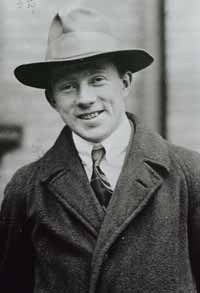 At the same time that the wave properties of matter were discovered, two further discoveries were made that also profoundly influenced (and confused) the future evolution of modern physics.
At the same time that the wave properties of matter were discovered, two further discoveries were made that also profoundly influenced (and confused) the future evolution of modern physics.
Firstly, Werner Heisenberg developed the uncertainty principle which tells us that we (the observer) can never exactly know both the position and momentum of a particle. As every observation requires an energy exchange (photon) to create the observed 'data', some energy (wave) state of the observed object has to be altered. Thus the observation has a discrete effect on what we measure, limiting how precisely we can determine both the position and momentum of the particle.
Max Born (1928) was the first to discover (by chance and with no theoretical foundation) that the square of the quantum wave equations (which is actually the mass-energy density of space) could be used to predict the probability of where the particle would be found. Since it was impossible for both the waves and the particles to be real entities, it became customary to regard the waves as unreal 'probability waves' and to maintain the belief in the 'real' particle.
Unfortunately this maintained the belief in the particle/wave duality, in a new form where the 'quantum' scalar waves had become 'probability waves' for the 'real' particle. Albert Einstein agreed with this probability wave interpretation, as he believed in continuous force fields (not in waves or particles) thus to him it was sensible that the waves were not real, and were mere descriptions of probabilities.
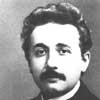 It seems to be clear, therefore, that Born's statistical interpretation of quantum physics is the only possible one. The wave function does not in any way describe a state which could be that of a single system; it relates rather to many systems, to an 'ensemble of systems' in the sense of statistical mechanics. (Albert Einstein, On Quantum Physics, 1954)
It seems to be clear, therefore, that Born's statistical interpretation of quantum physics is the only possible one. The wave function does not in any way describe a state which could be that of a single system; it relates rather to many systems, to an 'ensemble of systems' in the sense of statistical mechanics. (Albert Einstein, On Quantum Physics, 1954)
Albert Einstein was correct to realise that matter is not a discrete 'particle' but is spherically spatially extended. His error was to represent matter as a continuous spherical force field rather than a Spherical Standing Wave (a subtle but profound difference). Thus it is true that matter is intimately interconnected to all the other matter in the universe (by the spherical In and Out-waves). It is this lack of knowledge of the system as a whole that is the ultimate cause of the uncertainty and resultant probability inherent in Quantum Physics.
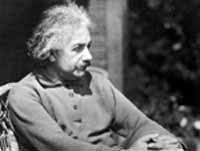 Thus the last and most successful creation of theoretical physics, namely quantum mechanics (QM), differs fundamentally from both Newton's mechanics, and Maxwell's e-m field. For the quantities which figure in Quantum Physics' laws make no claim to describe physical reality itself, but only probabilities of the occurrence of a physical reality that we have in view.
Thus the last and most successful creation of theoretical physics, namely quantum mechanics (QM), differs fundamentally from both Newton's mechanics, and Maxwell's e-m field. For the quantities which figure in Quantum Physics' laws make no claim to describe physical reality itself, but only probabilities of the occurrence of a physical reality that we have in view.
… I cannot but confess that I attach only a transitory importance to this interpretation. I still believe in the possibility of a model of reality - that is to say, of a theory which represents things themselves and not merely the probability of their occurrence. On the other hand, it seems to me certain that we must give up the idea of complete localization of the particle in a theoretical model. This seems to me the permanent upshot of Heisenberg's principle of uncertainty. (Albert Einstein, On Quantum Physics, 1954)
Albert Einstein believed that Reality was not founded on chance (as Bohr and Heisenberg argued) but on necessary connections between things (thus his comment 'God does not play dice.'). He was largely correct, matter is necessarily connected due to the Spherical Standing Wave Structure of Matter, but due to lack of knowledge of the system as a whole (the universe), this then gives rise to the chance and uncertainty found in Quantum Theory.
It is also true that we must give up the idea of complete localization and knowledge of the 'particle', which is merely a mathematical concept and is caused by the wave-center of the Spherical Standing Wave.
Remarkably, Stephen Hawking was very close to the truth when he wrote;
 But maybe that is our mistake: maybe there are no particle positions and velocities, but only waves. It is just that we try to fit the waves to our preconceived ideas of positions and velocities. The resulting mismatch is the cause of the apparent unpredictability. (Stephen Hawking, 1988)
But maybe that is our mistake: maybe there are no particle positions and velocities, but only waves. It is just that we try to fit the waves to our preconceived ideas of positions and velocities. The resulting mismatch is the cause of the apparent unpredictability. (Stephen Hawking, 1988)
Read more on the Wave Structure of Matter as a simple solution to the problems of Quantum Physics, Relativity, and Cosmology.
 Quantum Physics: Erwin Schrodinger Quotes
Quantum Physics: Erwin Schrodinger Quotes
The scientist only imposes two things, namely truth and sincerity, imposes them upon himself and upon other scientists. (Schrodinger)
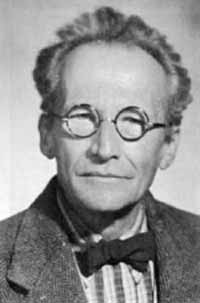 The world is given to me only once, not one existing and one perceived. Subject and object are only one. The barrier between them cannot be said to have broken down as a result of recent experience in the physical sciences, for this barrier does not exist.
The world is given to me only once, not one existing and one perceived. Subject and object are only one. The barrier between them cannot be said to have broken down as a result of recent experience in the physical sciences, for this barrier does not exist.
(Erwin Schrodinger)
There is nothing either good or bad but thinking makes it so. (Erwin Schrodinger)
Men and women for whom this world was lit in an unusually bright light of awareness, and who by life and word have, more than others, formed and transformed that work of art which we call humanity, testify by speech and writing or even by their very lives that more than others have they been torn by the pangs of inner discord. Let this be a consolation to him who also suffers from it. Without it nothing enduring has ever been begotten. (Erwin Schrodinger)
For a solitary animal egoism is a virtue that tends to preserve and improve the species: in any kind of community it becomes a destructive vice. An animal that embarks on forming states without greatly restricting egoism will perish. (Erwin Schrodinger)
We must not wait for things to come, believing that they are decided by irrescindable destiny. If we want it, we must do something about it. (Erwin Schrodinger)
We are, I believe, at the moment in grave danger of missing the 'path to perfection'. (Erwin Schrodinger)
Democritus introduces the intellect having an argument with the senses about what is 'real'.
The intellect says; 'Ostensibly there is colour, ostensibly sweetness, ostensibly bitterness, actually only atoms and the void.'
To which the senses retort; 'Poor intellect, do you hope to defeat us while from us you borrow your evidence? Your victory is your defeat.' (Erwin Schrodinger)
What we observe as material bodies and forces are nothing but shapes and variations in the structure of space.
Particles are just schaumkommen (appearances). ...
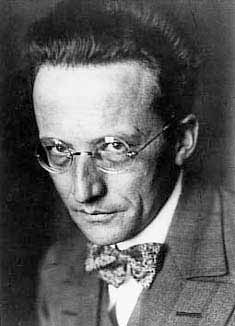 The world is given to me only once, not one existing and one perceived. Subject and object are only one. The barrier between them cannot be said to have broken down as a result of recent experience in the physical sciences, for this barrier does not exist. ...
The world is given to me only once, not one existing and one perceived. Subject and object are only one. The barrier between them cannot be said to have broken down as a result of recent experience in the physical sciences, for this barrier does not exist. ...
The scientist only imposes two things, namely truth and sincerity, imposes them upon himself and upon other scientists.
(Erwin Schrodinger)
Let me say at the outset, that in this discourse, I am opposing not a few special statements of quantum mechanics held today (1950s), I am opposing as it were the whole of it, I am opposing its basic views that have been shaped 25 years ago, when Max Born put forward his probability interpretation, which was accepted by almost everybody. (Schrödinger E, The Interpretation of Quantum Physics. Ox Bow Press, Woodbridge, CN, 1995).
I don't like it, and I'm sorry I ever had anything to do with it.
(Erwin Schrodinger talking about quantum mechanics)
References
Albert Einstein, Ideas and Opinions; Special and General Relativity. Crown, 1954
Erwin Schrodinger, What is Life? Mind and Matter, Cambridge University, 1967
 Erwin Schrodinger Biography
Erwin Schrodinger Biography
Erwin Rudolf Josef Alexander Schrödinger (August 12, 1887 – January 4, 1961) was an Austrian physicist famous for his contributions to quantum mechanics, especially the Schrödinger equation, for which he won the Nobel Prize in 1933. He proposed the Schrödinger's cat thought experiment, and he had a life-long interest in Vedanta.
Early years
In 1887, Schrödinger was born, in Vienna, to Rudolf Schrödinger (cerecloth producer, botanist) and Georgine Emilia Brenda. In 1898, he attended the Akademisches Gymnasium. Between 1906-10, Schrödinger studied in Vienna with Franz Serafin Exner (1849 - 1926) and Fritz Hasenöhrl (1874 - 1915). He also conducted experimental work in Kohlrausch. In 1911, Schrödinger became an assistant to Exner.
Middle years
 In 1914, Erwin Schrödinger achieved Habilitation (venia legendi). Between 1914-18, he was involved in war participation (Görz, Duino, Sistiana, Prosecco, Vienna). In 1920 April 6, Schrödinger married Annemarie Bertel. In 1920, he became the assistant to Max Wien, in Jena. In 1920, Sept. he attained the position of a. o. Prof. (Ausserordentlicher Professor), roughly equivalent to Reader (UK) or associate professor (US)), in Stuttgart. In 1921, he attained the o. Prof. (Ordentlicher Professor, i.e. full professor), in Breslau (presently Wroclaw, Poland)
In 1914, Erwin Schrödinger achieved Habilitation (venia legendi). Between 1914-18, he was involved in war participation (Görz, Duino, Sistiana, Prosecco, Vienna). In 1920 April 6, Schrödinger married Annemarie Bertel. In 1920, he became the assistant to Max Wien, in Jena. In 1920, Sept. he attained the position of a. o. Prof. (Ausserordentlicher Professor), roughly equivalent to Reader (UK) or associate professor (US)), in Stuttgart. In 1921, he attained the o. Prof. (Ordentlicher Professor, i.e. full professor), in Breslau (presently Wroclaw, Poland)
In 1922, he went to the Zürich University. In 1926, Schrödinger published in the Annalen der Physik the paper "Quantisierung als Eigenwertproblem" [tr. Quantisation as an Eigenvalue Problem] over wave mechanics and what is now known as the Schrödinger equation. In 1927, he followed Max Planck in Berlin to the Humboldt-University. In 1933, however, Schrödinger decided to leave Germany; he disliked the Nazi's anti-semitism. He became the Fellow of Magdalen College, University of Oxford. Soon after he arrived, he received the Nobel Prize together with Paul Adrien Maurice Dirac. His position at Oxford did not work out, it seems that his unconventional personal life (Schrödinger lived with two women) was not considered acceptable. In 1934, Schrödinger lectured at Princeton University and was offered a permanent position but did not accept it. Again, his wish to set up house with his wife and his mistress may have been a problem. There was also a possibility of his being offered a position at the University of Edinburgh but there were visa delays and in the end he returned, in 1936 to University Graz, Austria.
Later years
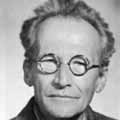 In 1938, after Hitler occupied Austria, he had problems due to leaving Germany in 1933 and his known opposition to Nazism. He issued a statement recanting this opposition, something he later regreted and for which he personally apologised to Einstein. However, this did not fully appease the new dispensation and he was dismissed from his job for political unreliability. He suffered harassment and was told not to leave the country. He and his wife fled to Italy. From there he went to visiting positions in Oxford and in the University of Ghent. In 1940 he was asked to help establish an Institute for Advanced Studies in Dublin, Ireland. He became the Director of the School for Theoretical Physics and remained there for 17 years. He wrote about 50 further publications on various topics. These were attempts towards a unified field theory.
In 1938, after Hitler occupied Austria, he had problems due to leaving Germany in 1933 and his known opposition to Nazism. He issued a statement recanting this opposition, something he later regreted and for which he personally apologised to Einstein. However, this did not fully appease the new dispensation and he was dismissed from his job for political unreliability. He suffered harassment and was told not to leave the country. He and his wife fled to Italy. From there he went to visiting positions in Oxford and in the University of Ghent. In 1940 he was asked to help establish an Institute for Advanced Studies in Dublin, Ireland. He became the Director of the School for Theoretical Physics and remained there for 17 years. He wrote about 50 further publications on various topics. These were attempts towards a unified field theory.
In 1944, he wrote "What is Life?" (which contains Negentropy, concepts for genetic code). According to James D. Watson's memoir, DNA, The Secret of Life, Schrödinger's 1944 book What is Life? gave Watson the inspiration to research the gene, which led to the discovery of the DNA double helix structure. He stayed in Dublin until retirement. During this time he remained committed to his particular passion; there were scandaluous involvements with students and he fathered two children by two different Irish women.
In 1956, he returned to Vienna (chair ad personam). At an important lecture during the World Power Conference he refused to speak on nuclear energy because of his scepticism about it (he gave a philosophical lecture instead).
In 1961, Schrödinger died in Vienna at the age of 73 (due to tuberculosis). He left a widow, Anny. He was buried in Alpbach (Austria)
Erwin Schrodinger Biography
https://en.wikipedia.org/wiki/Erwin_Schrodinger
Help Humanity
"You must be the change you wish to see in the world."
(Mohandas Gandhi)
 "When forced to summarize the general theory of relativity in one sentence:
Time and space and gravitation have no separate existence from matter. ... Physical objects are not in space, but these objects are spatially extended. In this way the concept 'empty space' loses its meaning. ... The particle can only appear as a limited region in space in which
the field strength or the energy density are particularly high. ...
"When forced to summarize the general theory of relativity in one sentence:
Time and space and gravitation have no separate existence from matter. ... Physical objects are not in space, but these objects are spatially extended. In this way the concept 'empty space' loses its meaning. ... The particle can only appear as a limited region in space in which
the field strength or the energy density are particularly high. ...
The free, unhampered exchange of ideas and scientific conclusions is necessary for the sound development of science, as it is in all spheres
of cultural life. ... We must not conceal from ourselves that no improvement in the present depressing situation is possible without
a severe struggle; for the handful of those who are really determined to do something is minute in comparison with the mass of the lukewarm
and the misguided. ...
Humanity is going to need a substantially new way of thinking if it is to survive!" (Albert Einstein)
 We can now deduce the most simple science theory of reality - the wave structure of matter in space. By understanding how we and everything around us are interconnected
in Space we can then deduce solutions to the fundamental problems of human knowledge in physics, philosophy, metaphysics, theology, education, health, evolution and ecology, politics and society.
We can now deduce the most simple science theory of reality - the wave structure of matter in space. By understanding how we and everything around us are interconnected
in Space we can then deduce solutions to the fundamental problems of human knowledge in physics, philosophy, metaphysics, theology, education, health, evolution and ecology, politics and society.
This is the profound new way of thinking that Einstein
realised, that we exist as spatially extended structures of the universe - the discrete and separate body an illusion. This simply confirms the
intuitions of the ancient philosophers and mystics.
Given the current censorship in physics / philosophy of science journals (based on the standard model of particle physics / big bang cosmology) the internet is the best hope for getting new knowledge
known to the world. But that depends on you, the people who care about science and society, realise the importance of truth and reality.
It is Easy to Help!
Just click on the Social Network links at top of page, or copy a nice image or quote you like and share it. We have a wonderful collection of knowledge from the greatest minds in human history, so people will appreciate your contributions. In doing this you will help a new generation of scientists see that there is a simple sensible explanation of physical reality (One Substance, One Law) - the source of truth and wisdom, the only cure for the madness of man! Thanks! Geoff Haselhurst (Updated May, 2025)
A new scientific truth does not triumph by convincing its opponents and making them see the light, but rather because its opponents eventually die, and a new generation grows up that is familiar with it. (Max Planck, 1920)
"All that is necessary for evil to succeed is for good people to do nothing."
(Edmund Burke)
"In a time of universal deceit - telling the truth is a revolutionary act."
(George Orwell)
"Hell is Truth Seen Too Late."
(Thomas Hobbes)
Legal Disclaimer and Privacy Policy












